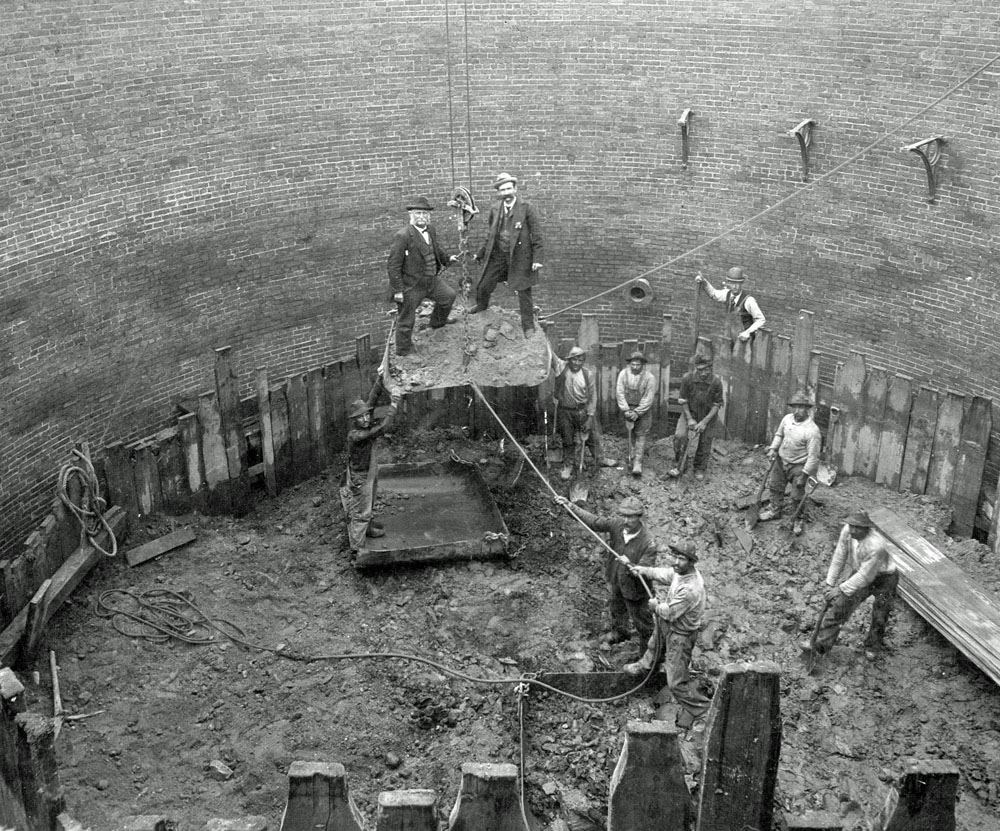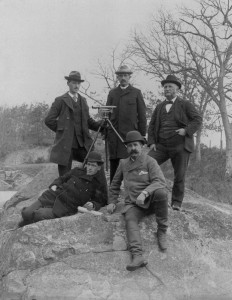True Tales: Frederic Endicott Part II
By George T. Comeau
Frederic Endicott and Michael Ward being lowered to inspect the digging of the well at Henry Springs in Stoughton in 1893. (Courtesy of the Canton Historical Society)
Click here for Part 1 of George Comeau’s profile on Frederic Endicott.
Perhaps water was in the Endicott family’s blood. There was a fairly antiquated water system in Canton developed in the late 1700s by William Crane. As it turns out, Crane was the great-grandfather of Endicott. The primitive system was constructed of wooden pipes that delivered water up the hill at Canton Corner Cemetery to Randolph Street.
Endicott was the person who is credited with developing the modern system of pipes, drainage culverts, street gutters, wells, and the overall water project that would keep the community safe. Using his superb skills of measurement and calculations, Endicott devised the locations for the town wells. Along with Charles Galligan, Endicott was named to the first Water Commission in 1889. It was no surprise that he would be involved as he was the most experienced engineer in Canton, and no one knew the topography of the town better.
The enterprise of bringing fresh water to Canton was an enormous undertaking. The initial system called for the construction of a filter-well at Springdale, a site that was chosen after careful runoff calculations done by Endicott. The system was connected by a ten-inch main pipe to Memorial Hall, a twelve-inch pipe to the summit of High Street where a standpipe would be connected, and an eight-inch main to Ponkapoag. Overall, more than 15 miles of pipe was needed to begin this service, with a team of 19 men to connect the services throughout the residential and industrial buildings. The well at Springdale (off present-day Pine Street) held 240,000 gallons of water, and the High Street standpipe held an additional 460,000 gallons of fresh water. More than half a million gallons of water could be pumped each day. Initially the system also included 125 fire hydrants and a telephone at the pumping station that enabled the firehouse to call for additional water pressure should a fire occur at a higher elevation where the system lacked sufficient pressure.
While Endicott’s greatest achievement may have been designing the water system, there are several other legacy projects for which he is credited. Most visibly, Endicott was one of the men who gathered together to see that a lending library could be created — which would eventually become the basis for the Canton Public Library. Endicott was also an avid genealogist and compiled the list of “Births, Marriages and Deaths of the town 1715 to 1845.” This book is widely respected and still in use today. Dozens of maps, drawings, plans, and sketches of land as it was in the mid 1800s still survive today, and his work is exact and wonderfully drawn.
Perhaps the greatest delight is in looking at the photography of Endicott. In the late 1800s and into the early 1900s, Endicott was a founder and president of the Kanton Kamera Klub. The KKK (as it was unfortunately known) pioneered the photographic views of our town, and the glass plate negatives are slowly being indexed at the Canton Historical Society. The KKK, under the direction and through the lens of Endicott, produced many of the views of Canton in the 1880s. Endicott favored winter scenes, and as a member of the Appalachian Mountain Club, his photography of the White Mountains was spectacular.

Surveying for the Canton Water Project in the 1880s. Endicott is pictured far right. (Courtesy of the Canton Historical Society)
What set Endicott apart was how diverse his interests were, yet always driven to his beloved town of Canton. At various times he served as superintendent of schools, selectman, library trustee, tax collector, water commissioner, and hydraulic engineer. A true scientist, he writes in his diary on June 11, 1897, “220 miles from Boston to Randolph, found 3 white and cream colored Cypripedium Acaule not yet out of bloom.” He had found the Lady’s Slipper while visiting the Mt. Crescent House in Randolph, New Hampshire.
In 1916, Endicott suffered a shock from which he never fully recovered. Selling his business interest to Charles P. Reynolds, Endicott quietly retired in the house he was born in, the brick house on the hill.
In a small leather journal kept by Endicott’s daughter, Charlotte Wilde, she writes simply on Tuesday, March 12, 1918, “ Pa E passed away at 3:15 today very quiet and peacefully at the last.” Two days later, “rain and snow all day, Pa E put in tomb at Canton Cemetery.” At the funeral, Reverend Harold Arnold remarked upon a life of uprightness and honesty “as unswerving as the needle of his compass.”
The grave of Frederic Endicott stands in a long line of grey and white markers, all of the Endicott family. Recently, at the expense of the Historical Commission, his leaning and endangered stone was reset so his mark on Canton can continue. And yet, every time you turn on the water in your house, you may also think about Frederic Endicott and his remarkable life in Canton.
Short URL: https://www.thecantoncitizen.com/?p=11389










